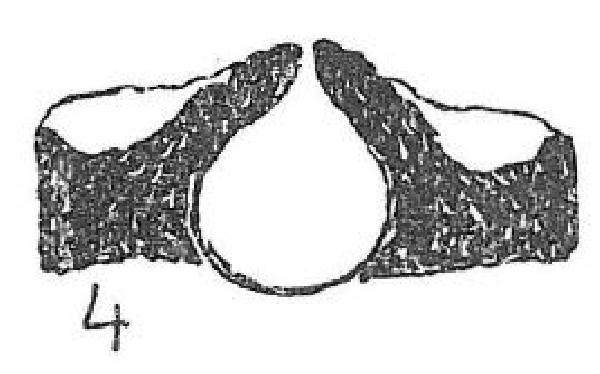Verrucaria asperula Servít
Sborn. Národn. Mus Praze, 5, B, 9, bot. 3: 15, 1949.
Synonyms:
Distribution: N - Lig. C - Tosc.
Description: Thallus crustose, episubstratic, rimose-areolate, dark brown to black, 0.15-0.35 mm thick, without a distinct prothallus, the areoles with a finely papillose to granulose surface, angular, flat, 0.2-1(-2) mm wide, separated by broad fissures into smaller units. Cortex 10-25(-30) µm thick, brown in uppermost part, overlain by a thin epinecral later; algal layer discontinuous, interrupted by black columns originating from the medulla; medulla black, occupying up to 2/3 of thallus thickness. Perithecia black, entirely immersed or projecting with the apical part, 1-5(-15) per areole, the apical part flattened to convex, shiny, 0.1-0.25 mm across. Involucrellum closely adpressed to exciple, black, laterally 50-70 µm thick, extending down to the black basal layer; exciple subglobose, 0.2-0.3 mm across, the wall 15-20 µm thick, colourless to pale brown; hamathecium of 15-25 µm long periphyses and periphysoids, interascal filaments absent; hymenial gel hemiamyloid, I+ red (I+ blue at very low concentrations of I), K/I+ blue. Asci 8-spored, clavate, I-, fissitunicate, the wall thickened above, with an ocular chamber, dehiscent by extrusion of an endotunica to form a delicate rostrum, Verrucaria-type. Ascospores 1-celled hyaline, ellipsoid, 15-22 x (6-)7-9(-11) µm. Photobiont chlorococcoid. Spot tests: K-, C-, KC-, P-, UV-. Chemistry: without lichen substances.Note: a poorly known species described from Germany and also reported from the French Alps, growing on siliceous rocks in relatively warm sites, mostly below treeline.
Growth form: Crustose
Substrata: rocks
Photobiont: green algae other than Trentepohlia
Reproductive strategy: mainly sexual
Poorly known taxon in need of further study
Commonnes-rarity: (info)
Alpine belt: absent
Subalpine belt: very rare
Oromediterranean belt: very rare
Montane belt: rare
Submediterranean belt: extremely rare
Padanian area: absent
Humid submediterranean belt: extremely rare
Humid mediterranean belt: absent
Dry mediterranean belt: absent

Predictive model
Herbarium samples
Growth form: Crustose
Substrata: rocks
Photobiont: green algae other than Trentepohlia
Reproductive strategy: mainly sexual
Poorly known taxon in need of further study
Commonnes-rarity: (info)
Alpine belt: absent
Subalpine belt: very rare
Oromediterranean belt: very rare
Montane belt: rare
Submediterranean belt: extremely rare
Padanian area: absent
Humid submediterranean belt: extremely rare
Humid mediterranean belt: absent
Dry mediterranean belt: absent

Predictive model
| Herbarium samples |
 INDEX FUNGORUM
INDEX FUNGORUM
 GBIF
GBIF


